Sitewide Sale: Use code Get5Nutra for 5% OFF all products. FREE shipping & 30-Days Hassle-Free ReturnsShop Now
Navigating the best plants for hydroponics can be daunting, but some selections stand out for their adaptability and ease of growth. This guide cuts through the complexity, highlighting plants like lettuce, herbs, and green onions that not only adapt well to hydroponic systems such as NFT, DWC, and Ebb and Flow but also promise quick harvests and forgiving growth patterns for hydroponic enthusiasts.
Beginner-friendly hydroponics plants like leaf lettuce, herbs, and green onions are ideal for those new to the method, offering ease of growth, fast harvest cycles, and resistance to common issues.
Hydroponic gardening efficiency is enhanced by matching plant types to the appropriate systems, such as NFT for shallow-rooted plants, DWC for oxygen-loving crops, and ebb and flow for plants needing aerated roots.
Success in hydroponic gardening involves managing nutrient levels, understanding light requirements, and selecting equipment suited to plant needs, along with advanced techniques for experienced growers.
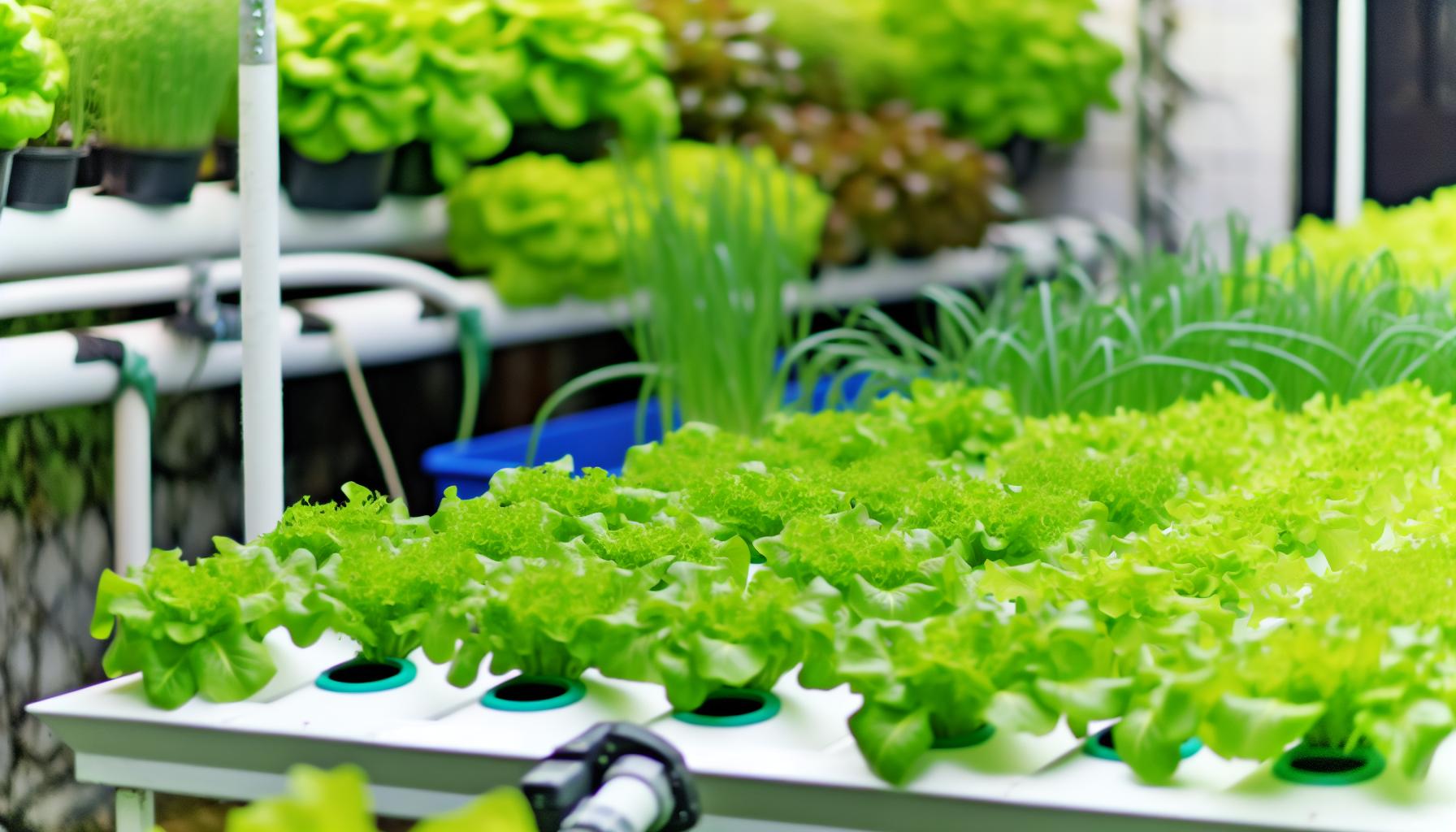
Embarking on a hydroponic gardening venture can be quite thrilling. Choosing the correct plants is crucial for success, especially those that absorb nutrients well, adapt to life without soil, and are compatible with your hydroponic system’s environment.
Understanding plant nutrition essentials and how to manage your system is vital for flourishing in hydroponic gardening. It’s also essential to take into account factors such as available space, budget constraints, and the types of plants you wish to grow. So which beginner-friendly plants are optimal for growing in a hydroponic garden? Here we look at three top choices: leaf lettuce, various herbs, and green onions.
The judicious choice of appropriate plants will greatly influence the effectiveness and yield of your hydroponic garden. Thus it’s advisable to begin with species that are straightforward when it comes both to cultivation practices and care requirements. This approach lets you master the intricacies of managing a hydroponic setup while reaping its rewards.
Leaf Lettuce
Spinach
Basil
Mint
Chives
Kale
These selections have proven themselves amenable when grown using this method. They’re typically easier-going on maintenance needs yet flourish within a properly set-up hydronic ecosystem. Enjoy delving into the world of hydroponics!
Also Read :
The journey of hydroponic gardening is rewarding, particularly when you witness quick results. That’s where leaf lettuce comes in. Known for its fast growth and simple nutrient needs, leaf lettuce is a top choice for those new to hydroponic gardening. Within weeks, you’ll be able to harvest your first crop, a rewarding experience for any beginner.
The simplicity of growing leaf lettuce in hydroponic systems makes it an ideal starter plant. Its straightforward nutrient requirements are perfect for newcomers who are still learning about hydroponic nutrient management. All these characteristics make leaf lettuce an easy and efficient starter plant for anyone venturing into the world of hydroponics.
Incorporating herbs such as cilantro, parsley, and basil into your hydroponic garden can elevate the experience by infusing an aromatic aspect into this fruitful pursuit. These particular herbs are well-suited to thrive in hydroponic systems like NFT (Nutrient Film Technique) because they have modest root systems and grow quickly.
The delight that comes from plucking fresh herbs right from your hydroponic setup is immense. Not only do these freshly harvested greens enhance the taste of your meals, but they also allow you to reap the benefits of engaging in hydroponic gardening.
Green onions are an ideal choice for those seeking a sturdy and easy-to-maintain option in their hydroponic garden. They provide resilience for beginners dabbling with hydroponics as they withstand most typical plant diseases well and tolerate minor changes in water and nutrient levels.
In just 3 to 4 weeks following planting, green onions can be harvested from your hydroponic system, plus they offer the added benefit of being able to regrow multiple times after cutting—giving you several harvests from one initial planting effort. Maintenance involves little more than periodically ensuring that the water level is adequate and the nutrient solution is properly balanced.
Due to their modest nutrient requirements, growing green onions doesn’t necessitate elaborate or complex hydroponic systems. Using just plain water can prove quite effective.
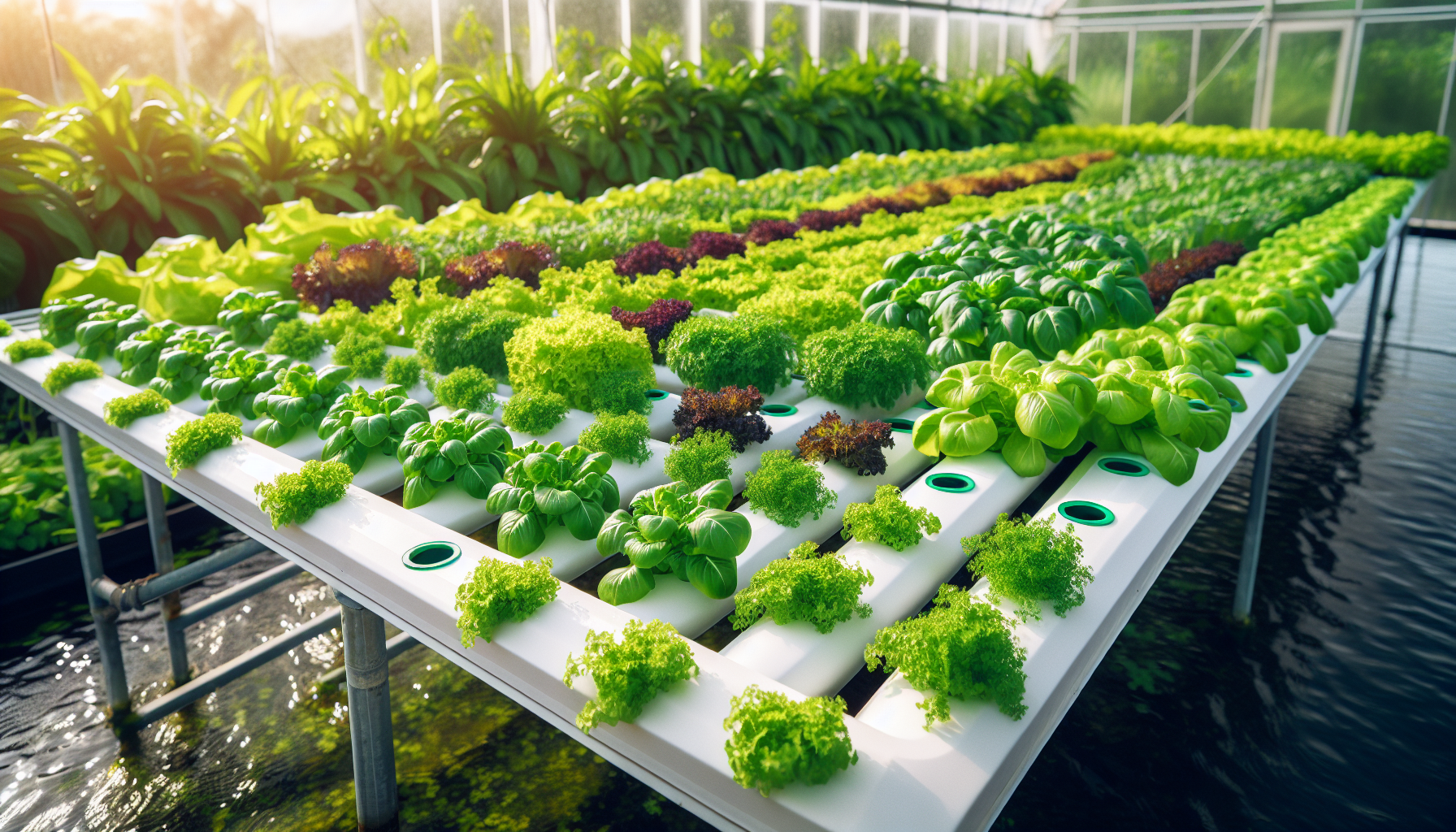
Nutrient Film Technique (NFT) systems are ideal for cultivating plants with shallow roots and fast growth, like leafy greens and herbs. This hydroponic garden method enables a continuous flow of nutrient-rich water across the plant roots by circulating it through inclined channels, thereby providing essential nutrients required for optimal growth.
With its versatility and expandability, the NFT system is an excellent choice for compact indoor gardens as well as more expansive commercial ventures that must maximize the use of limited space. It’s worth mentioning though, that heftier vegetables with extensive root networks or longer growing periods such as cabbages may not be suitable candidates for this technique since they can potentially disrupt the steady movement of the nutrient solution.
Consider mustard greens and Swiss chard specifically: these two varieties thrive under Nutrient Film Technique NFT conditions due to their rapid maturation rates. They contribute valuable nutrients when integrated into a hydroponic garden setup.
The peppery-flavored mustard greens from the Brassicaceae family are an ideal choice for NFT (Nutrient Film Technique) setups due to their light structure and compact root system, which thrive in nutrient-rich shallow water flows.
These plants mature rapidly and offer nutritious foliage, making them a valuable crop for inclusion in your hydroponic garden.
Swiss chard, a leafy green known for its gentle and mildly bitter flavour profile, flourishes in NFT (Nutrient Film Technique) hydroponic systems. It stands out with lively, colourful foliage that can enhance the visual appeal of your hydroponic gardens. Around four to five weeks following planting in an NFT system, you can begin successive harvesting by cutting back approximately 75% of the plant. This promotes Growth.
Not only does Swiss chard contribute essential nutrients suitable for a balanced diet, but it also serves as a decorative feature within your hydroponic garden space.
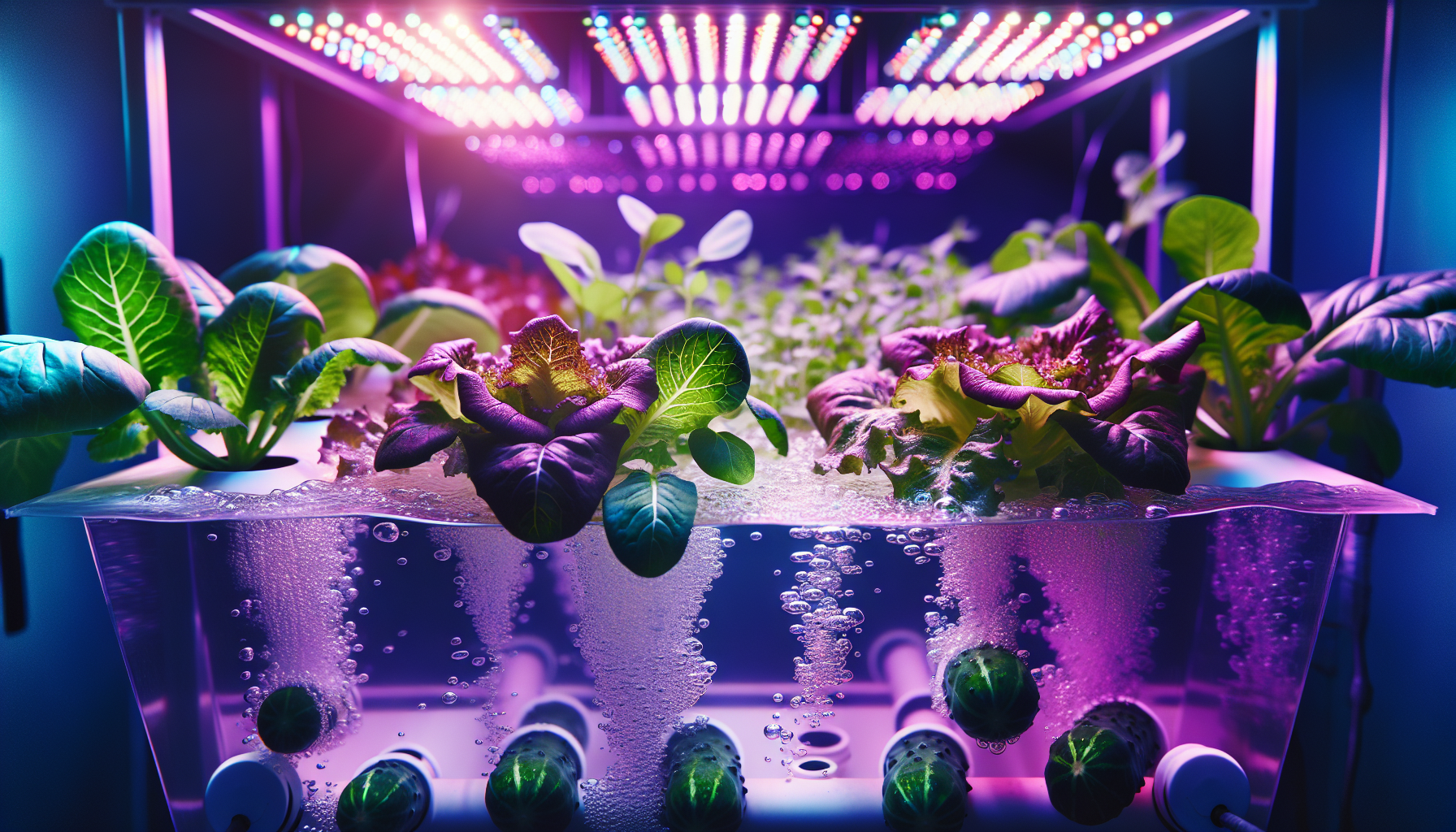
The Deep Water Culture (DWC) hydroponic method is highly regarded for its suitability to plant species that flourish in well-aerated environments. In such DWC setups, the plant roots are immersed in water enriched with oxygen, which enhances rapid growth and leads to greater production volumes. Leafy greens, including varieties like butterhead, romaine, oakleaf, and multi-leaf lettuces, thrive exceptionally well under this system. It’s equally favourable for growing culinary herbs such as sorrel, arugula, and basil.
Several crops particularly excel when grown using DWC systems:
Kale
Collard greens
Bok choy
Tatsoi
Cucumbers
These specific plants reap the advantages of consistent access to nutrients and moisture available within a DWC setup. The unending stream of oxygen-rich water fosters healthy development leading to rich harvests.
Focusing on two prominent examples thriving within DWC systems, basil and cucumbers serve not just as aromatic delights but also exemplify the high-efficiency cultivation enabled by these hydroponics plants’ methods.
Basil thrives in your hydroponic garden, especially within DWC systems, because of its remarkable ability to adapt and the intense flavour it brings. The herb’s bright and fragrant foliage provides both a sensory pleasure and a culinary delight.
To savouring basil’s strong taste from fresh picks, you also gain the advantage of being able to harvest it regularly within these water-based growing setups.
Due to their growth tendencies, swift development, and impressive production levels, cucumbers are perfectly suited for Deep Water Culture (DWC) systems. These plants necessitate a consistent water replenishment routine because of their significant hydration needs for producing fruit. Nevertheless, with attentive maintenance, cucumbers can yield an abundant crop that enriches your DWC setup.
Flood and drain, also known as ebb and flow systems, provide a versatile hydroponic solution that can accommodate an array of plants. These types of hydroponic systems are particularly well-suited for cultivating herbs, salad greens, and other plants that benefit from substantial lighting and airflow.
In these setups, the growing tray holding the plant roots sits atop a substrate while a secondary container stores the water mixed with nutrient solution. This design periodically floods the root area then drains it to ensure roots receive both nutrients and oxygen effectively.
Optimal plant candidates for cultivation in flood and drain hydroponics plants include:
Strawberries
Tomatoes
Cucumbers
Peppers
Lettuce
Spinach
-Radishes
-Beans
-Basil
-Oregano
-Mint
On we will delve into strawberries along with bell peppers specifically—as they are two crops that show remarkable growth success within flood-and-drain type hydroponic configurations.
Strawberries thrive in ebb and flow hydroponics plants systems as they benefit greatly from the highly aerated and oxygen-rich root conditions these systems provide. The continuous fruiting of day-neutral strawberries makes them a favoured choice for growers using hydroponic ebb and flow methods, given that the conditions remain ideal.
The delightful experience of savouring freshly harvested strawberries is matched by the gratifying process of cultivating them within your own living space.
Sweet and spicy types of bell peppers thrive in ebb-and-flow hydroponic systems, where they benefit from a nutrient solution that is balanced and capable of supporting their vertical growth. To achieve optimal growth in these hydroponic bell peppers, it’s critical to maintain the pH level of the nutrient solution between 5.5 and 6.5.
This careful cultivation results in a bounty with bold colors and unique tastes that distinguish your home-cultivated bell peppers from others.
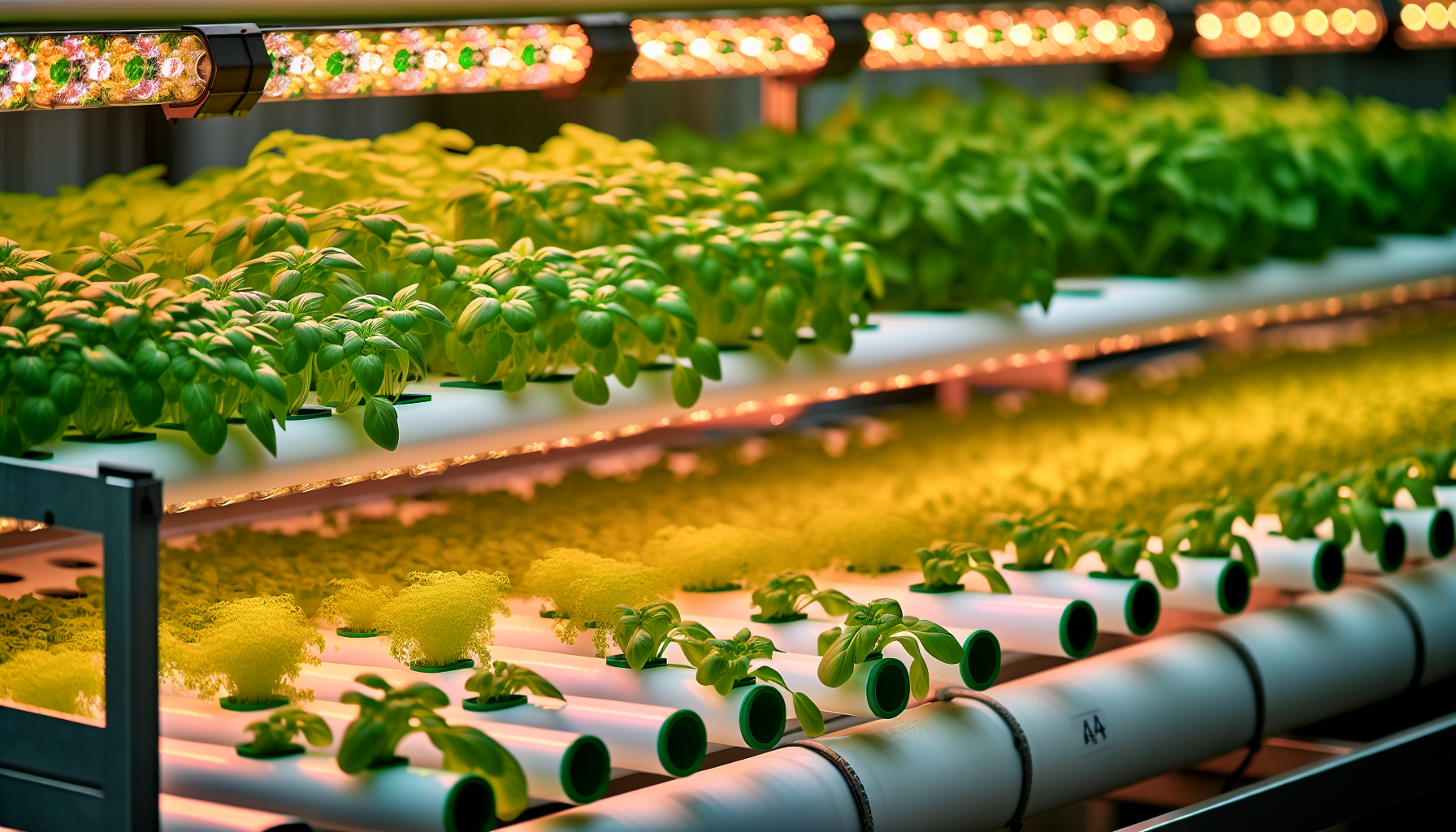
A key advantage of hydroponic gardening is the power to manipulate the growing environment for optimal growth. For optimal plant growth in hydroponic systems, it is essential to ensure:
Adequate light intensity
Optimal temperature
Proper humidity levels
Sufficient carbon dioxide (CO2) levels
These factors play a crucial role in the plant’s development and overall health.
Understanding specific nutrient requirements is vital for successful hydroponic gardening, paving the way for lush growth in the garden. Water and air quality significantly influence plant health by impacting nutrient availability, pH stability, and the potential for pests and diseases, with adequate oxygen levels being important for root respiration and nutrient uptake.
Achieving success in hydroponics plants farming involves understanding and overcoming various challenges, which include following expert tips and optimizing light intensity and duration based on the plant’s growth stage. In the following sections, we’ll examine the role of light and nutrients in fostering optimal growth in your hydroponic garden.
Light is a pivotal element for plant development within hydroponic systems. Composed of photons with diverse wavelengths, the light spectrum includes essential colours like blue, ranging from 450-490 nm, and red, spanning from 635-700 nm. Plants predominantly utilize the Photosynthetically Active Radiation (PAR) spectrum between 400-700 nm to carry out photosynthesis. Photons outside this wavelength range do not significantly contribute to this process.
The specific wavelengths of light elicit varied responses in plants—red light impacts their overall size while blue light results in more compact and robust vegetative growth. Full-spectrum grow lights provide an even distribution of all colour spectrums that effectively replicate natural sunlight conditions and support continuous plant growth through various stages. Advanced LED grow lights are engineered to fine-tune the spectral output to enhance both yield and quality optimally.
Just as all living beings require certain nutrients to flourish, plants do too. Within a hydroponics plants system, this nourishment is delivered through a specifically designed nutrient solution that provides both macro and micro elements essential for plant growth. This includes key macronutrients such as nitrogen, phosphorus, and potassium, vital micronutrients like calcium, magnesium, and sulfur, and trace minerals such as iron and zinc.
For the efficient uptake of these essential nutrients in hydroponics plant setups, it’s imperative to sustain proper levels of pH and electrical conductivity (EC). Regular monitoring along with adjustments when necessary ensures optimal conditions for nutrient absorption. Attention must also be given consistently to cleaning activities. Calibration should be precise while hydration probes used for measuring pH and EC demand routine care—all steps indispensable if one seeks healthy plant development within their hydroponic garden.
Once you have mastered the fundamental principles of hydroponic gardening, it might pique your interest to explore more sophisticated methods. By adopting advanced propagation strategies like tissue culture, grafting, and air layering, one can boost both the efficiency and success rates within their hydroponic systems.
For promoting robust growth in taller species of hydroponic plants, high-intensity discharge lighting options such as metal halide or high-pressure sodium lights are highly effective due to their deep canopy penetration abilities. They emit more heat, which necessitates an efficient cooling system. Deploying advanced tactics for optimizing CO2 concentrations can greatly improve photosynthetic performance in these controlled plant environments.
Let’s turn our attention to certain types of flora that require a higher level of care within hydroponic gardens: tomatoes and some exotic varieties stand out here. These particular plants may present a degree of difficulty when cultivating them. With sufficient expertise under your belt—they offer substantial fulfilment upon successful cultivation.
Cultivating hydroponic tomatoes involves a nuanced process that, when done correctly, yields significant rewards. Those adept in growing tomatoes within this system must be aware of the varied nutritional demands throughout the plant’s lifecycle. Employing a fertilizer blend tailored for tomatoes with a ratio of 4-18-38 and enhanced by chelated micronutrients, coupled with additional calcium and magnesium supplements, is key to fostering healthy tomato plants while averting issues such as blossom end rot.
Hydroponic tomato plants have an intense need for water during their fruit-bearing phase, which necessitates a stringent schedule for replenishing water supplies. Consistent pruning is also essential in directing the plant’s vitality towards producing fruit and maintaining strong growth at its core stem. By meticulously monitoring and tending to these plants’ needs, one can reap an abundant yield of succulent tomatoes right from home.
Experienced hydroponic garden enthusiasts seeking an exciting test of their skills may find great joy in cultivating unusual exotic plants. Among the distinctive varieties that can flourish within a hydroponic setting, you’ll discover:
Lemongrass
Dragon fruit
Chinese watercress
Tamarillo
To ensure these unique species prosper, they necessitate particular substrates tailored for hydroponics and precise environmental conditions. Although this might require additional dedication, the reward of effectively nurturing such rare specimens in your hydroponic garden is indeed extraordinary and fulfilling.
Maximizing Yield and Health in Your Hydroponics Plants System
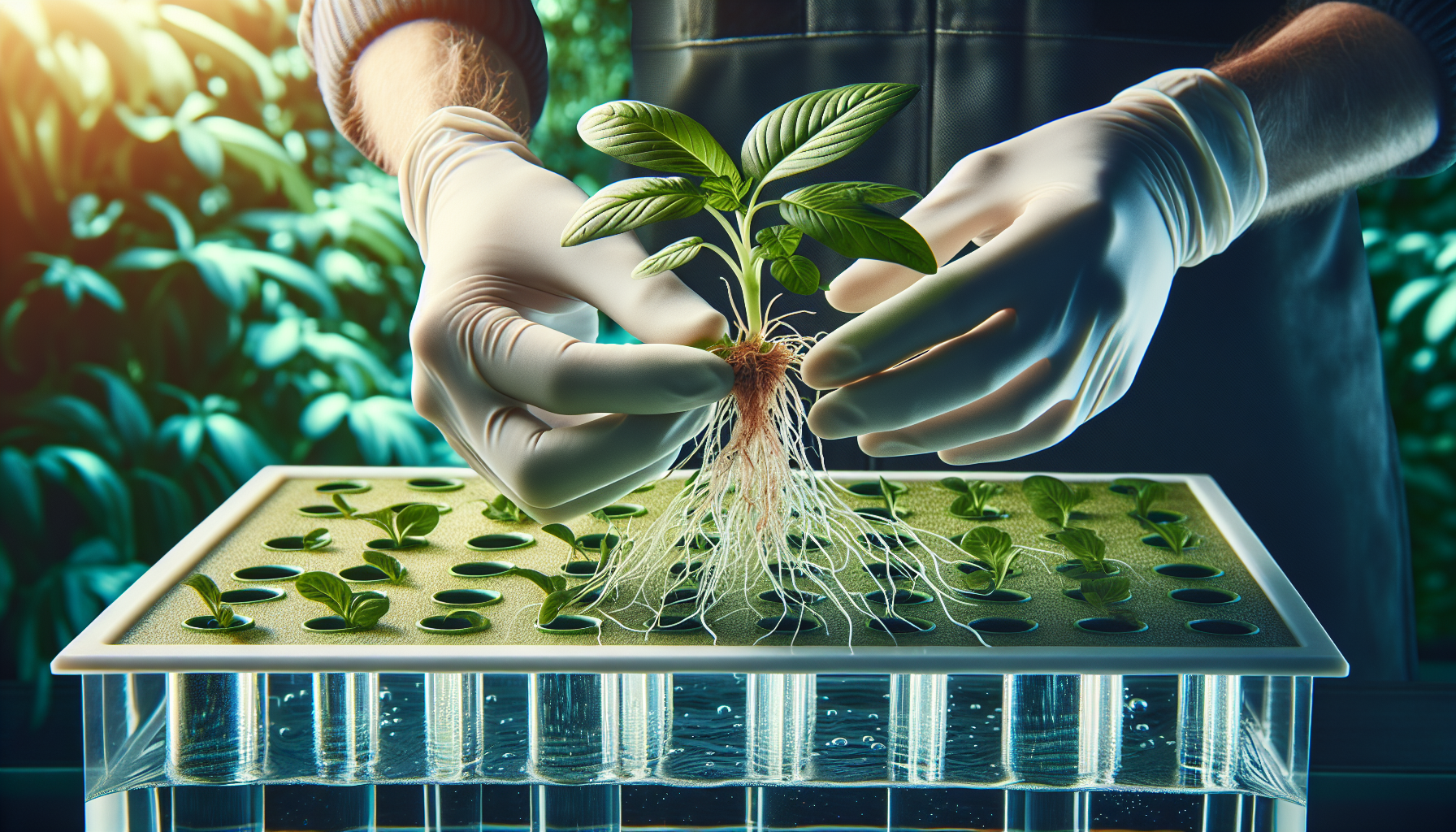
Maintaining a routine in the care of your hydroponic garden is vital for achieving optimal yields and ensuring plant vitality. This involves consistent pruning, effective pest control strategies, and precise nutrient level adjustments. Good management practices along with clear communication within the team are essential components in running a thriving hydroponic garden.
Ensuring water quality is paramount to securing good health for plants grown using hydroponic techniques. Key factors such as pH balance, concentration of nutrients, and appropriate water temperature can greatly influence plant growth and yield potential. It’s worth noting that these advanced gardening systems often allow growers to reap multiple cycles of harvests from their crops—commonly three to five times—which underscores their efficiency.
Moving forward, we will delve into proven methods for both efficient pruning operations and integrated pest management approaches tailored specifically towards improving production rates and overall vigour within your hydroponic gardening endeavours.
Pruning is essential for controlling the accelerated growth rates of plants in hydroponic systems, which often surpass those grown in soil. It helps with upkeep and aids weaker root systems. Techniques employed within hydroponics plants to prune effectively include:
Trimming basil to encourage denser growth in Deep Water Culture (DWC) setups.
Removing wilted or infected leaves as a measure to inhibit disease proliferation.
Cutting back surplus foliage to preserve desired plant shape and proportions.
Snipping away flower buds so that energy can be refocused on leafy development.
Applying these pruning methods can significantly improve both the yield and appearance of crops cultivated through hydroponic techniques.
In terms of mustard greens, it’s advisable to harvest no more than 30% at once, while basil should be harvested between 50–60 days post-transplantation. During this process, a portion ranging from one-third up to two-thirds of the top foliage may be removed. This promotes not only thicker vegetation but also spurs subsequent regrowth.
Even a hydroponic system is susceptible to pest invasions. Inhabitants such as aphids, thrips, spider mites, fungus gnats, and whiteflies can be kept in check with the use of sticky traps or treatments like insecticidal soaps and sprays containing pyrethrin or neem oil. A proactive approach to preventing these pests involves reducing plant stress through careful nutrient management, optimizing humidity levels within the environment and curtailing algae growth from the outset.
For effective control over these unwanted visitors within your hydroponic garden, it may become necessary to apply treatments multiple times every 10 days while ensuring that any plants showing signs of infestation are quarantined promptly—this helps prevent contaminating other sections of your setup. Vigilance against pests not only maintains plant well-being but also safeguards both the quality and safety of your cultivated produce for harvesting.
The role of equipment in the successful practice of hydroponic gardening is critically important. Key pieces of this essential equipment include:
Grow lights
Pumps
Timers
pH and EC meters
Securing appropriate gear, customized to the size and specific type of your operation, can vastly enhance your experience with hydroponic gardening.
Crucial apparatus for an indoor garden includes:
Grow lights that offer ample illumination necessary for plant growth
Systems designed to regulate temperature and humidity, warding off issues like mould formation and nutrient burn
Growing trays or tables intended for effective water management and stable plant support
A water reservoir specifically suited for hydroponic configurations.
Assorted growing mediums such as Rockwool, coco coir, perlite, and clay pellets are available to accommodate the various needs of different plants.
In our forthcoming discussions, we will delve into detailed information concerning grow lights along with monitoring devices which are indispensable components within a hydroponics setup.
When setting up indoor hydroponic gardens, it is essential to provide plants with the proper lighting. It’s vital to consider not only light intensity—commonly measured in lumens or photosynthetically active radiation (PAR) value—but also the spectrum of light offered and how energy-efficient the grow lights are. The particular type of illumination a bulb produces is an important detail to note for your hydroponic system because different types of vegetation have distinct photoperiod needs.
When calculating costs associated with hydroponic systems’ lighting setup, both initial expenses and long-term electricity consumption should be factored in. Take for example a 9-watt LED grow light that typically incurs around $5.44 annually in electrical costs and necessitates a replacement expense of about $15 every half-decade. Choosing appropriate lighting tailored for your specific hydroponics arrangement can markedly influence plant growth outcomes as well as yields from your crops.
In hydroponic systems, it is essential to accurately monitor and maintain the correct pH levels and Electrical Conductivity (EC). The availability and absorption of nutrients by plants are heavily influenced by the pH level. EC is an indicator that reveals how much nutrient strength there is in the solution by measuring dissolved nutrient concentration. For example, for Swiss chard to thrive in NFT systems, it necessitates maintaining an EC range between 1.8 2.3.
Maintaining plant health and efficient nutrient uptake requires consistent care of pH and EC meters—including frequent cleaning, calibration, and hydration of probes—and conducting daily checks at a routine time every day is advisable. Advanced hydroponic growers can leverage remote monitoring technologies to oversee system parameters from afar on the go effectively managing real-time adjustments that foster conditions conducive to optimal growth of their plants.
Selecting appropriate plants for your hydroponic system’s configuration is a crucial step toward achieving success in hydroponic gardening. Plants that are compact and grow quickly, while having similar nutrient needs, tend to thrive better in such systems. It’s vital to ensure adequate lighting and warmth as these elements play an essential role in plant growth.
The physical dimensions of the plants, particularly the root size, should guide the choice of containers within hydroponic setups. For instance, using recirculating deep water culture (DWC) systems can accommodate varying root lengths well. With innovative design solutions, even limited space issues can be addressed effectively. Tailor-made DIY hydroponic systems provide flexibility regarding spatial limitations and financial constraints—making them a practical alternative for non-conventional growing environments like cities.
In forthcoming sections we will delve into two major considerations when picking out plants for your hydroponic setup: accommodating the spatial requirements and ensuring compatibility with the type of system you have chosen.
Vegetables such as lettuce, along with herbs, often flourish when cultivated in a hydroponic water culture. Conversely, plants that bear fruit like tomatoes, cucumbers or peppers might not excel as much within this type of growing system.
For optimal growth in hydroponic systems, the rapid-growth herbs basil, cilantro, mint, and parsley necessitate between 12 to 16 hours of daily light exposure.
Indeed, adept cultivators utilizing a hydroponic system can successfully nurture unique plant species such as lemongrass, dragon fruit, and Chinese watercress by catering to their particular substrate requirements and creating the precise growing conditions needed.
To enhance the yield and maintain plant health in your hydroponic system, it’s crucial to consistently implement techniques such as pruning, managing pests, and maintaining nutrient levels. These strategies are key for boosting production while ensuring the well-being of your plants.
The right equipment, such as grow lights, pumps, timers, and pH and EC meters, is essential for successful hydroponic gardening, impacting the overall experience significantly. Using tailored equipment suitable for the scale and system type is crucial for optimal results.
It’s critical to factor in the space available when selecting plants for hydroponic gardening to guarantee adequate development and light exposure. Take bell peppers as an example. They necessitate considerable room within hydroponic systems, demanding at least one foot of separation between individual plants. Systems based on Deep Water Culture frequently employ a 5-gallon bucket per plant, which requires additional space and is ideal for species that prosper when immersed in water.
For newcomers to hydroponic gardening, beginning with less spatially intensive test crops can be beneficial before moving on to cultivating a broader range of potentially bigger plants.
System Compatibility: Matching Hydroponics Plants to Methods
It’s essential to pair plants with suitable hydroponic systems for effective cultivation. For instance:
NFT (Nutrient Film Technique) hydroponic systems are a good match for growing mustard greens.
Plants such as basil, lettuce, and kale are frequently recommended for DWC (Deep Water Culture) systems.
The Kratky method is a passive option that allows the growth of tomatoes without requiring complicated pump setups, ideal for those who prefer more straightforward approaches.
Recognizing your plants’ particular requirements and selecting the right hydroponic system accordingly can significantly affect the prosperity of your garden.
Hydroponic systems go beyond mere plant cultivation techniques. They represent a progressive approach to conserving water by substantially minimizing the amount of water used. Conventional soil-based agriculture by capturing and recycling water, thereby lessening wastage and excess drainage. For plants grown hydroponically, thriving requires an ideal pH range between 5.4 and 7 which necessitates regular monitoring and modification of the pH levels in the system’s water.
Sustainability is reinforced within hydroponic gardens when organic waste gets converted into nutrient solutions rather than contributing to landfill accumulation. Examples like worm tea or homemade compost concoctions are viable options that provide nutrients for plants within organic hydroponic setups. This practice not only bolsters sustainability but also improves the environmental impact of these garden systems.
The subsequent sections will delve into two principal sustainable practices intrinsic to hydroponics: efficient reuse along with conservation of water, plus incorporation of organically derived nutrient solutions.
One of the major advantages of hydroponic systems is their efficient water use. Hydroponic systems use up to 10 times less water than traditional field crop watering methods by capturing and reusing water, thereby reducing runoff and drainage. Most water loss in hydroponic systems is through plant transpiration, with minimal evaporation, making these systems ‘closed’ or mostly closed systems.
Conservation in hydroponics is also promoted by:
Topping up nutrient solutions instead of complete replacements reduces water and fertilizer consumption
Utilizing vertical hydroponic systems, which are a form of water-saving, closed, or semi-closed systems
Using organic nutrients, optimizing the use of space and resources
Implementing hydroponic systems can contribute to sustainability by saving water and utilizing space inefficient for traditional agriculture.
In hydroponic gardens, it’s essential to pair the supply of water with appropriate nutrients for optimal plant health. Although there is some contention around their certification, the environmental advantages of such systems are considerable even in the absence of organic labels. A crucial element that bolsters both sustainability and ecological impact within hydroponic setups is the incorporation of organic waste into nutrient-rich water solutions.
Crafting your nutrient mixtures using elements like worm tea and compost can lay a sustainable foundation for organically driven hydroponics plants. By integrating fish emulsion with sources of organic calcium and nitrogen, one can curate an equilibrium in nutritional provision tailored for plants grown hydroponically. Coconut coir stands out as a renewable medium conducive to root support and moisture conservation, seamlessly integrating into an eco-conscious approach to nurturing plants via hydroponics. With judicious use of these organic nutrient solutions, your efforts can yield a thriving yet environmentally considerate harvest from your very own sustainably run hydroponic system.
We’ve explored the wide world of hydroponic gardening, from the basic principles to advanced techniques. We discovered that the success of your hydroponic garden lies in selecting the right plants and matching them to the appropriate hydroponic systems. We’ve learned that maintaining optimal growth involves managing light spectrums and nutrient levels, and that equipment like grow lights and monitoring tools play a pivotal role. We’ve also delved into how to maximize yield and health in your hydroponic system and the importance of creating a sustainable hydroponic garden.
Whether you’re a beginner looking to dip your toes into hydroponic gardening or an experienced grower seeking to expand your knowledge, remember that the journey is just as important as the destination. So equip yourself with the right knowledge, choose your plants wisely, and embrace the challenge. Here’s to lush, vibrant growth in your hydroponic garden!
Vegetables such as lettuce, along with herbs, often flourish when cultivated in a hydroponic water culture. Conversely, plants that bear fruit like tomatoes, cucumbers or peppers might not excel as much within this type of growing system.
For optimal growth in hydroponic systems, the rapid-growth herbs basil, cilantro, mint, and parsley necessitate between 12 to 16 hours of daily light exposure.
Indeed, adept cultivators utilizing a hydroponic system can successfully nurture unique plant species such as lemongrass, dragon fruit, and Chinese watercress by catering to their particular substrate requirements and creating the precise growing conditions needed.
To enhance the yield and maintain plant health in your hydroponic system, it’s crucial to consistently implement techniques such as pruning, managing pests, and maintaining nutrient levels. These strategies are key for boosting production while ensuring the well-being of your plants.
The right equipment, such as grow lights, pumps, timers, and pH and EC meters, is essential for successful hydroponic gardening, impacting the overall experience significantly. Using tailored equipment suitable for the scale and system type is crucial for optimal results.
Grow 100 planting sites, monitor ph levels, water temperature, water levels, and control light and water cycles.
© Copyright 2024 Nutraponics. All Rights Reserved.